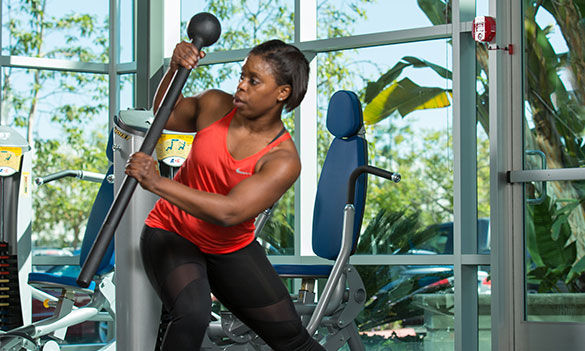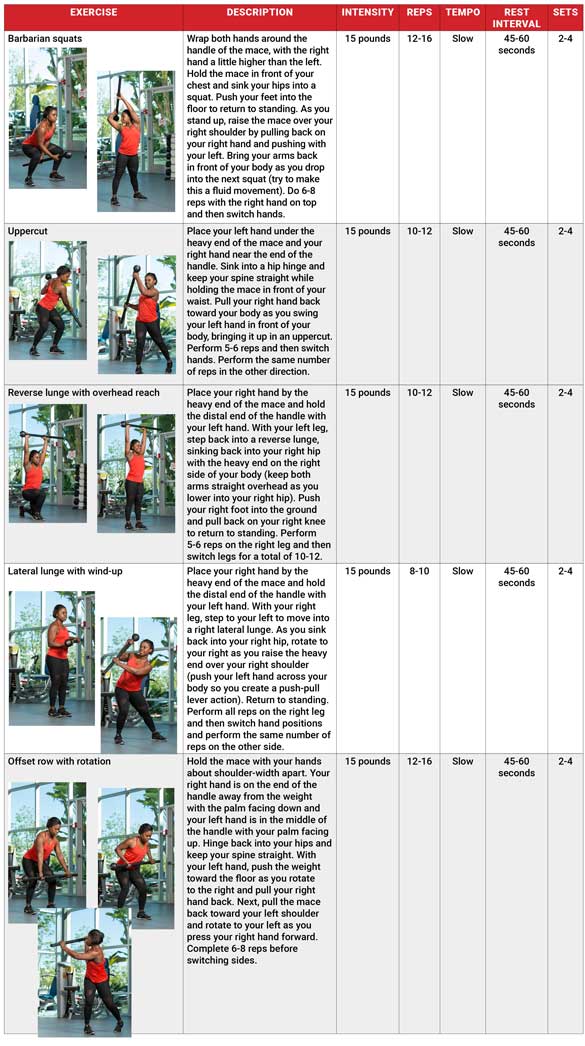
Game of Thrones is a popular series on HBO about quasi-medieval knights, wizards, witches and nobles battling over control of a mythical land. If you’re familiar with the show, you may have noticed that the sword fighting and battle scenes are excellent examples of multidirectional, multiplanar, full-body strength-training workouts. Have you ever held an actual sword or mace? They can be really heavy, so any knight or maiden wielding one in battle would have to be extremely strong to be able to defeat his or her opponent. No, you didn’t stumble onto some sci-fi fanboy site or fantasy live-action role-playing (LARP) blog. Rather, this installment of ACE’s series examining the latest exercise equipment, we’re reviewing a new strength-training product based on an ancient weapon: the ominous-sounding mace by Onnit.
The Product
Onnit started out making supplements to improve brain function and physical performance, but later began selling exercise equipment and fitness education based on techniques used by the earliest generations of strongmen (and women). While the fitness industry has recently been focused on using technology such as wearables, workout apps and expensive interactive displays, Onnit is bucking this trend by reviving age-old techniques that are decidedly low-tech, but extremely effective.
The mace, which consists of a metal ball at the end of a solid metal handle approximately one meter in length, is currently one of the most popular products Onnit sells on its website. It comes in a variety of weights but only two sizes: the 7-pound mace is 31.5” long, while the 10-, 15-, 20- and 25-pound versions measure 40.5”. The primary feature of the mace as an exercise tool is that it is an asymmetrical, unbalanced load. Because all of the weight is located at the end of the handle, when moved through space the mace creates multiple torques (rotational forces) that are capable of strengthening skeletal muscle, elastic fascia and other connective tissues simultaneously.
While the mace isn’t a “new” invention, it is an innovative adaptation of a weapon that was once used in hand-to-hand combat. Before the modern era of firearms, planes and tanks, soldiers, warriors and knights would undergo rigorous strength training to prepare for the physical challenges of swinging swords, maces and battle-axes in hand-to-hand combat. In fact, many of the earliest fitness programs were developed to improve the strength of soldiers training for warfare. It takes a tremendous amount of physical effort to control a heavy implement and move it through multiple planes of motion. Using swords and maces to train for the demands of combat helped warriors develop the strength necessary to be successful on the battlefield.
Manufacturer Claims
Flash forward to the 21st century. Today, instead of preparing warriors to fight, the team at Onnit, led by Chief Fitness Officer John Wolf, is helping die-hard fitness enthusiasts, professional athletes and Hollywood celebrities get in the best shape of their lives via methods that have largely been overlooked by the modern era of got-to-have-it-now, technology-driven solutions.
“In a historical context, training for martial arts and warfare involved not just physical preparation but mental conditioning as well. Being successful in battle meant having a strong mind-body connection,” explains Wolf. “Tools like the mace require a tremendous amount of strength to control the momentum of the mass, which helps to develop the mental acuity needed to properly handle the implement.”
The result, says Wolf, “is significant changes to both cognitive decision-making and reflexive reactivity.”
According to Wolf, learning how to swing a Mace improves the timing of muscle contractions. “The disproportionate weight displacement of a Mace engages both tonic muscles used for stability as well as phasic muscles responsible for creating movement by challenging them to control momentum leading to significant improvements in strength,” he says. He also recommends starting with a lighter mass when first starting to exercise with a mace. In this way, the exerciser can develop acceleration, muscle coordination, speed and overall timing of contractions before progressing to the heavier loads necessary to improve strength and power.
Wolf credits recent trends such as strength-training programs for “tactical athletes” (the term given to soldiers, law enforcement officers and first responders), shows like Game of Thrones and movies like Assassin’s Creed, and LARPing with foam swords, battleaxes and maces, for helping to increase interest in the benefits of whole-body conditioning using maces. He also points to our technology-dominated lifestyles, which puts us in constant contact with keyboards and screens. Wolf believes that holding a mace is a primal act that resonates with an innate need to use our hands.
“Even in the 21st century, with all of its modern conveniences, we are still connected with our primal selves. We have to acknowledge that over time our hands evolved to be capable of swinging club-like objects to either hunt for food or to fight for protection, not for simply tapping on computer keys.”
Here are some additional benefits of training with a mace, according to Wolf and his team at Onnit:
- Using the mace allows a user to train with rotational forces, which can help improve shoulder and hip function, while also increasing the ability to generate force in linear directions.
- Using a low-tech tool with an unbalanced load like the mace can help improve the mind-body connection, allowing users to achieve a state close to meditation while strength training. “The mace allows individuals to coordinate a series of discrete movement patterns into a flowing movement sequence that can help improve the mind-body connection in a way that is not easily replicated with other strength-training tools,” asserts Wolf.
- The length of the handle and the offset weight allow users to perform pushing and pulling movements at the same time. For example, when doing an offset row with rotation (see workout, below) the hand closest to the weight is pushing down toward the ground while the hand on the handle is pulling back. When the body is rotating the hand closest to the weight is pulling while the other hand is pushing.
First Impressions
Admittedly, when we first saw a mace featured in a workout, our first thought was: “Why not just use a sledgehammer for the same types of multiplanar movements?” But once you start moving with an actual mace, it becomes obvious that one of the mace’s primary benefits is that the long handle provides extensive leverage, which results in more options for hand placement when holding and maneuvering the weight. (A quick search of a hardware-store’s website reveals that sledgehammer handles average between 34” and 36” in length, while the handles of the heavier maces are 40.5”. While this might seem like a minor disparity, the additional handle length makes a big difference for the strength required to control and maneuver the leverage of the weighted end).
It takes a few minutes to learn how to properly position your hands and become comfortable with the push-pull leveraging created by the offset weight and the length of the handle, but once you do you will really enjoy the feeling of handling the mace. In fact, remember how you felt when you first lifted a substantial amount of weight? How invincible you felt? Learning how to properly handle a mace offers that same sense of mastery and satisfaction.
While the metal on the handle is textured to provide a grip, it can get slippery when you are sweating, and you will sweat. Adding grip tape to the handle might help with holding the mace with wet hands, but tape can also collect nasty microbes and bacteria, so this is not an ideal solution.
You should be prepared to feel sore after your first mace workouts—the rotational movements and off-set loading engage many, if not all, of the muscles responsible for controlling motion of the scapulae on the rib cage. There are 17 different muscles that connect each scapula to the body, and it may be possible to feel every single one of them the day after your first mace workout.
The Response
Regardless of the type of exercise you perform—linear or dynamic—a weight at the end of a long handle creates a unique method for loading force into the body.
“The mace is a humbling tool,” says Josh Meltzer, fitness manager at Equinox in Carlsbad, Calif. “When used properly, you can make a light mace feel heavy and a heavy mace feel light. And, because of the asymmetrical, off-balanced weight, the mace teaches users how to brace properly to stabilize the spine while pushing and pulling with the opposing hands at the same time.”
John Bauer, wellness director at Club Sport in Fremont, Calif., echoes Meltzer’s assertion that the mace offers users a significant challenge. Here’s how he described his first experience using one: “Even though I should know better, I picked up a mace and tried to ‘muscle’ through the movements. What you learn very quickly is that it’s not really about strength, but more about how to control an unbalanced load while it is moving.”
However, explains Bauer, learning how to properly use a mace can help improve coordination as well as strength. “The mace is a unique tool because most of the weight is on one end, which makes it easy to create some momentum, but at the same time provides a challenge that can help clients develop the proper muscle timing between strength and stability,” he says. “A proper training program with a mace can help a client master this timing to develop a smooth, visible rhythm to their movement patterns.”
Matt Berenc, director of education for Equinox health clubs, is a big fan of the mace and the concept of relying on historical methods to develop effective exercise techniques. He also supports Wolf’s idea that the mace allows us to get back to a more primal relationship with exercise.
“On a very base, emotional level, working with a mace just feels good,” says Berenc. “I know this is less-than-technical, but sometimes just the fun of swinging a heavy implement (safely) is all the reason you need.”
Of course, that’s not the only reason Berenc likes the mace. “It allows for a variety of training stresses that are not easily produced with other devices,” he asserts. “For instance, given the extreme asymmetrical loading of a mace, I am able to create leverage challenges on the body that either increase the stresses needed to be controlled, such as rotation or lateral flexion, or facilitate getting into position through offsetting body weight.”
Workout Options
The design of the mace creates a number of benefits that makes it suitable for clients of a wide range of skill levels to use it to get stronger.
“Having the weight loaded to one side on a long handle makes it possible to engage in a variety of exercises and allows for different entry points based on level of ability,” explains Berenc. “For instance, someone who is newer to using a mace would still be able to reap the benefits by just bringing their hands closer to the head. This shortens the lever arm, making it easier for them to control. Conversely, a more advanced person can do the same move with the same weight but use a different hand position and be challenged exponentially more. This is only one example, but I think its level of versatility is unique when compared to other exercise equipment.”
Learning how to lift, move and swing the mace is not that difficult, nor is it particularly dangerous as long as a client has established an optimal level of stability and mobility throughout his or her body. The primary concern with using a mace in a health club or gym setting is other members who may not be paying attention or have the presence of mind to watch out for a swinging implement. Therefore, when using a mace it is essential to have a dedicated space that can allow a client to move freely so as not to impede upon other members trying to complete their workouts on the gym floor. It is up to you to ensure that you and your client have ample space to maximize the safety for other club members.
Introductory Mace Workout
The purpose of this workout is to introduce clients to exercising with an asymmetrical load using a mace. Cue clients to maintain a long, straight spine, with rotation coming from the hips and thoracic spine. Start with slow, controlled movements; as the client’s skill level improves, he or she can begin to move faster and more explosively.

While it can be credited with increasing the popularity of training with a mace, Onnit is not the only company producing asymmetrical weights. Power Systems, for example, sells the Core Hammer by MostFit, and other vendors are starting to market similar products in an effort to capitalize on the mace’s popularity.
It is worth noting that, because this type of training places a tremendous amount of force into the tissues and systems of the body, it is important to learn how to properly control an unbalanced load moving through multiple movement patterns. To help your clients gain the greatest benefits of training with a mace, consider taking an education course to learn safe, effective techniques for designing and coaching exercise programs. And be sure to practice the moves yourself so you know exactly how to lead your clients to success.





 by
by 



